
Lotus, a latinization of Greek lōtos (λωτός), is a genus that includes most bird's-foot trefoils and deervetches and contains many dozens of species distributed worldwide. Depending on the taxonomic authority, roughly between 70 and 150 are accepted. Lotus is a genus of legumes and its members are adapted to a wide range of habitats, from coastal environments to high altitudes.

The California Floristic Province (CFP) is a floristic province with a Mediterranean-type climate located on the Pacific Coast of North America with a distinctive flora similar to other regions with a winter rainfall and summer drought climate like the Mediterranean Basin. This biodiversity hotspot is known for being the home of the Sierran giant sequoia tree and its close relative the coast redwood. In 1996, the Province was designated as a biodiversity hotspot allowing it to join ranks among 33 other areas in the world with many endemic species. To be named a biodiversity hotspot, an area has to contain species and plant life that cannot be found anywhere else in the world. The California Floristic Province is home to over 3,000 species of vascular plants, 60% of which are endemic to the province.
Philip Alexander Munz, botanist, taxonomist and educator (1892–1974), of the Rancho Santa Ana Botanic Garden, was Professor of Botany at Pomona College, serving as Dean for three years.
The Jepson Manual is a flora of the vascular plants that are either native to or naturalized in California. Botanists often refer to the book simply as Jepson. It is produced by the University and Jepson Herbaria, of the University of California, Berkeley.

Iris munzii is a species of iris which is endemic to the Sierra Nevada foothills of Tulare County, California, mostly in the vicinity of the Tule River. It is quite rare in the wild. Its common names include Tulare lavender iris and Munz's iris. Its flowers grow in inflorescences of three to four per stem, and are usually lighter shades of purple and blue with darker veining.
Hosackia crassifolia, synonym Lotus crassifolius, is a species of legume native to Washington, California and Oregon. It is known by the common names big deervetch and broad-leafed lotus.
Allium bolanderi is a species of wild onion known by the common name Bolander's onion. It is native to northern California and southwestern Oregon, where it grows in the rocky soils of the Klamath Mountains and surrounding regions.
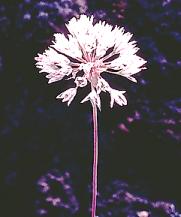
Allium jepsonii is a species of wild onion known by the common name Jepson's onion, honoring renowned California botanist Willis Linn Jepson.

Hosackia gracilis, synonym Lotus formosissimus, is a species of legume native to western North America from British Columbia through Washington and Oregon to California. It was first described by George Bentham. It is known by the common name harlequin lotus. It grows in moist spots in the coastal mountains and down to the oceanside bluffs. It is a perennial herb growing upright or spreading to about 0.5 m in maximum length. It is lined with leaves each made up of a few oppositely arranged oval leaflets up to 2 cm long. The inflorescence is made up of several pealike flowers each 1 to 2 cm long. The flower has a bright yellow banner, or upper petal, and bright pink or white lower petals. The fruit is a legume pod 2 to 3 cm long.
Syrmatium haydonii, synonyms Lotus haydonii and Acmispon haydonii, is a species of legume native to California. It is known by the common names rock bird's-foot trefoil, Haydon's lotus, and pygmy lotus. It is native to the dry mountain slopes and deserts of southern California, mainly the deserts of eastern San Diego County, where it grows in scrub and woodland habitat. It is a small bushy perennial herb spreading with mostly naked, slender stems. The sparse leaves are made up of usually three tiny leaflets and are deciduous. The inflorescence is generally made up of one or two yellow to reddish pealike flowers each under a centimeter long. The fruit is a curved legume pod also under a centimeter long.
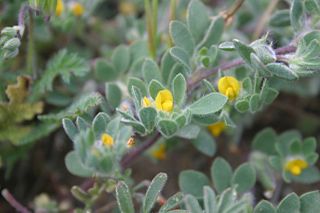
Acmispon brachycarpus is a species of legume known by the common name foothill deervetch. It is native to western North America from Idaho to Texas to northern Mexico, where it is known from many types of habitat. It is an annual herb spreading upright or taking a clumpy or matted form. It is lined with leaves each usually made up of four hairy, somewhat fleshy leaflets each up to about 1 cm long. Solitary yellow, pea-like flowers appear in the leaf axils. The fruit is a legume pod variable in size and shape.
Hosackia incana, synonym Lotus incanus, is a species of legume native to California. It is known by the common name woolly bird's-foot trefoil. It is endemic to the Sierra Nevada of California, where it grows in forests and other mountain habitat.
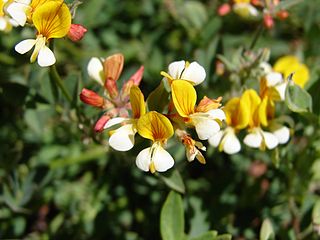
Hosackia oblongifolia, synonym Lotus oblongifolius, is a species of legume native to western North America from Oregon to northern Mexico. It is known by the common name streambank bird's-foot trefoil or meadow lotus. It grows in moist to wet areas in several types of habitat. It is a spreading or upright perennial herb lined with leaves each made up of 3 elongated oval leaflets each up to 2.5 centimeters long. The inflorescence bears several yellow and white flowers between 1 and 2 centimeters long. The fruit is very elongated, reaching up to 5 centimeters in length but just a few millimeters in width.
Hosackia pinnata, synonym Lotus pinnatus, is a species of legume native to western North America from British Columbia to California. It is known by the common names meadow bird's-foot trefoil and bog bird's-foot trefoil. Its distribution extendsg into British Columbia in just a few rare occurrences near Nanaimo. It grows in moist to wet habitat, such as bogs and spring meadows. It is a hairless perennial herb lined with leaves each made up of green oval leaflets each 1 to 2.5 centimeters in length. The inflorescence is an array of up to 10 pealike flowers between 1 and 2 centimeters long. Each flower has a bright yellow banner, or upper petal, and white lower petals. The fruit is a slender, elongated legume pod up to 5 centimeters long but just a few millimeters long.
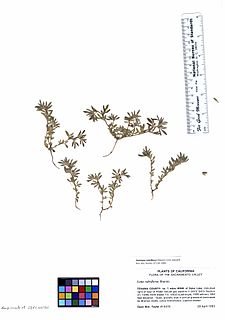
Acmispon rubriflorus, synonym Lotus rubriflorus, is a species of legume endemic to California. It is known by the common name red-flowered bird's-foot trefoil. It is known from only four occurrences with a disjunct distribution. There are two occurrences in eastern Stanislaus County, California, near Mount Boardman, and the other two occurrences are in Colusa and Tehama Counties over 100 miles to the north. The plant's habitat is grassland and woodland. This is a petite annual herb spreading in a small patch on the ground. Its slender branches are lined with leaves each made up of about 4 hairy lance-shaped leaflets. Solitary magenta flowers appear in the leaf axils, each minute pea-shaped bloom just a few millimeters wide. The fruit is a hairy legume pod which may approach a centimeter in length.
Hosackia stipularis, synonym Lotus stipularis, is a species of legume endemic to California. It is known by the common name balsam bird's-foot trefoil. It is found in most of the northern and central coastal and inland mountain ranges and foothills. It can be found in many types of habitat, including forest, chaparral, and disturbed areas. This is a mostly erect perennial herb with a leafy, often hairy and glandular form. Its slender branches are lined with leaves each made of several leaflets up to 2 centimeters long. The leaves sometimes have prominent stipules. The inflorescence is a compact array of up to 9 pink flowers. Each flower is elongated, the corolla borne in a tubular calyx of sepals, and the entire unit may exceed a centimeter long. The fruit is a legume pod 2 or 3 centimeters long containing several beanlike seeds.

Acmispon is a genus of flowering plant in the family Fabaceae (legumes), native to North America and the west coast of Chile in South America. It includes several species of American bird's-foot trefoils and deervetches formerly contained in the globally distributed genus Lotus.
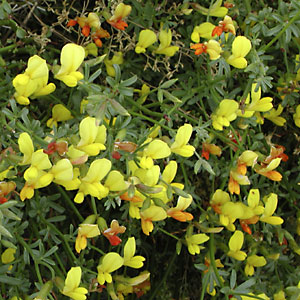
Ottleya rigida, synonyms Lotus rigidus and Acmispon rigidus, is a flowering plant in the pea family (Fabaceae), native to the southwestern United States and northwestern Mexico. It is known as shrubby deervetch or desert rock-pea. It is found in the Mojave Desert and Sonoran Desert.

Hosackia is a genus of flowering plants in the family Fabaceae (legumes). It is native to western North America, from British Columbia in Canada to Mexico.

Syrmatium is a genus of flowering plants in the family Fabaceae (legumes). It is native to the southwestern United States.












